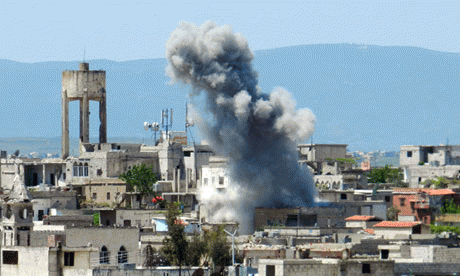"It is not unlike Sherlock Holmes and the dog that didn't bark. It's not just that we can't prove a sarin attack, it is that we are not seeing what we would expect to see from a sarin attack." ~~ Jean-Pascal Zanders, former senior research fellow at the European Union's Institute for Security Studies
Sherlock Holmes, Sir Arthur Conan Doyle's fictional detective, cracked the case of the "Silver Blaze" by concluding that a murder and theft had to be an inside job because the watchdog never barked. It would be a good idea to keep this in mind when it comes to determining whether the Syrian government used poison gas against its opponents. And since the Obama administration is citing "proof" that the chemical warfare agent sarin was used by the Syrian government as the basis for escalating its intervention in the two-year old civil war, this is hardly an academic exercise.
Like Holmes, start with the facts.
According to French, British, Israeli and U.S. intelligence services, the regime of President Bashar al-Assad used sarin on at least 10 different occasions, resulting in the deaths of some 100 to 150 people. The "proof" for this is based on tissue and blood samples -- British intelligence claims contaminated soil as well -- from victims of the attacks. The samples were gathered in Syria, taken to Turkey, and turned over to the intelligence services and the United Nations.
The French newspaper Le Monde also reports that one of its reporters suffered blurred vision and nausea during one of these attacks, and the paper has published photos of purported victims being treated. There is, as well, a video of insurgent fighters donning gas masks. Besides the photos and video images, no evidence has been released to the press.
What about the beast itself?
The chemical was invented in Germany in 1938 as a pesticide. It is a nerve agent -- as opposed to a "blistering agent" like mustard gas -- and kills by blocking the body's ability to control the chemical that allows muscles to turn themselves off. As the Office of Emergency Management puts it, "Without an 'off switch,' the glands and muscles are constantly being stimulated. They may tire and no longer be able to sustain breathing function."
You suffocate.
Sarin is a colorless and odorless liquid, and it is "volatile" -- that is, it quickly turns into a gas. Even in small concentrations, it is very deadly and can kill within minutes. It is absorbed through the skin or lungs and can contaminate clothing for up to 30 minutes. The British created a far deadlier and less volatile variant of sarin called V. It was an errant VX cloud from the U.S. Army's Dugway Proving Ground that killed some 6,000 sheep in Colorado's Skull Valley in 1968.
Many countries have chemical weapons, but some, including the U.S. and Russia, are in the process of destroying them under the 1993 Chemical Weapons Convention. Sarin is considered a "weapon of mass destruction" under UN Resolution 687, although that label is a bit of a misnomer. It is certainly bad stuff. In 1988 Saddam Hussein used sarin to kill several thousand Kurds in the city of Halabja, and sarin and mustard gas were used during the Iran-Iraq War (1980-88). It is estimated that gas inflicted about 5 percent of Iran's casualties in that war.
But poison gas is generally considered more of a nuisance than a weapon capable of creating large numbers of dead and wounded. It only accounted for 1 percent of the casualties in World War I, and doesn't compare with a real weapon of mass destruction. The two nuclear bombs dropped on Hiroshima and Nagasaki killed some 250,000 people and injured hundreds of thousands more. And by today's standard of nuclear weapons, those bombs were tiny.
While chemical weapons are scary, they are no more indiscriminate in what they kill than 1,000 lb bombs and cluster weapons, indeed much of the arsenals of modern armies. Small arms, for instance, inflict 90 percent of civilian casualties.
In any case, President Obama made the use of chemical weapons in the Syrian civil war his "red line," a barrier he claims has now been breached.
Has it?
Philip Coyle, a senior scientist at Washington's Center for Arms Control and Non-Proliferation has his doubts, telling the McClatchy newspapers that from what he has observed of the evidence, it doesn't look as if sarin was used.
Jean-Pascal Zanders, former head of the Chemical and Biological Warfare Project at the Stockholm international Peace Research Institute questions some of the reports in Le Monde. For instance, the newspaper reports that victims traveled a long distance for medical care, which he suggests is unlikely if sarin was used. He also points out there are no reports of medical workers dying from exposure to victims, even though sarin clings to clothing for up to a half hour. He also questions a Le Monde report that one victim was given 15 shots of the antidote atropine, a dose that would surely have been fatal.
(Note: You can view every article as one long page if you sign up as an Advocate Member, or higher).






